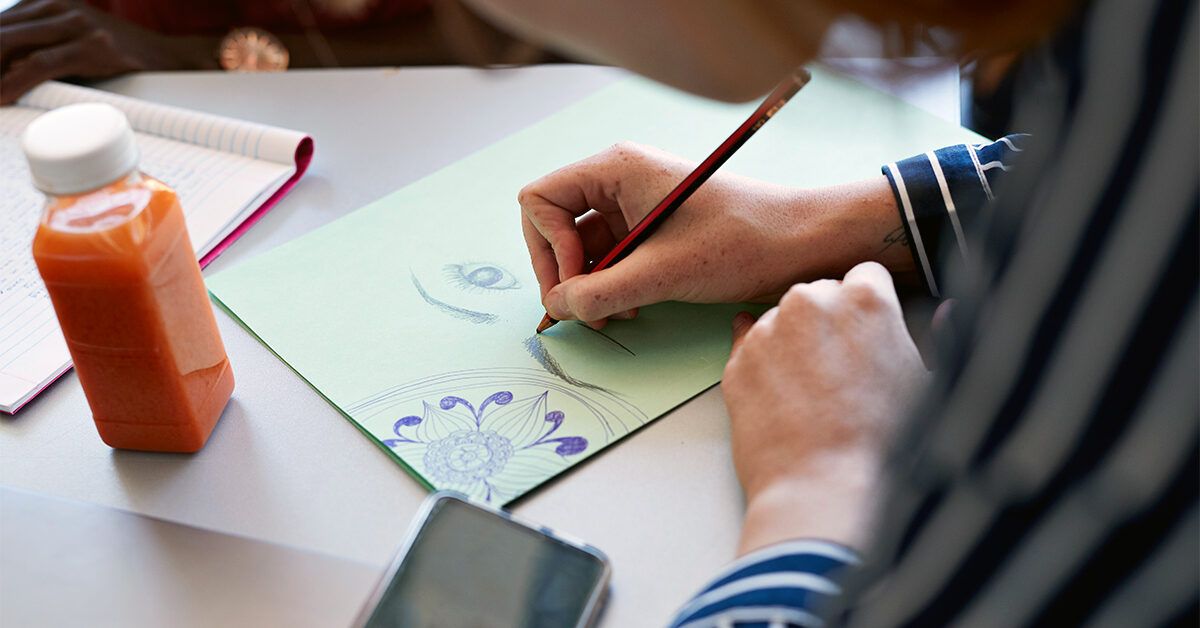Last Updated on June 18, 2025 by Jaclyn A. Neeley
Drawing on yourself with a pen is highly unlikely to cause skin cancer. While inks may contain solvents that can seep into the bloodstream through open wounds and some inks may contain chemicals linked to cancer, skin cancer is mainly caused by excessive UV light exposure.
Drawing on the skin can have negative effects, weakening the immune system and causing allergies to ink. Permanent markers can lead to permanent scars and should be avoided for drawing tattoos. Sharpies are considered non-toxic on the skin but may provoke allergies in some people.
Sharpie also offers body markers specifically designed for drawing on human skin without causing allergic reactions in most people. Despite the potential risks, the likelihood of developing skin cancer directly from drawing on oneself is very minimal.
The Risks
Before you start using a pen to draw on your skin, it’s essential to understand the potential risks associated with this practice. While it may seem harmless at first glance, there are certain factors you should consider to ensure the health and safety of your skin. This section will delve into the various aspects of using pens on your skin and provide insights into the potential risks involved.
Pen Composition And Skin Interaction
When it comes to drawing on your skin, the type of pen you use plays a crucial role. Different pens contain varying compositions that can have different effects on the skin. For instance, some pens may contain harsh chemicals or allergens that can cause adverse reactions when they come into contact with the skin. It’s important to be mindful of the composition of the pen you plan to use and its potential interaction with your skin to avoid any negative consequences.
Potential Harmful Effects
While drawing on your skin may seem like a fun and harmless activity, it’s essential to be aware of the potential harmful effects it can have. Excessive or prolonged exposure to the ink from pens can lead to skin irritation, allergic reactions, or other adverse effects. Additionally, certain pens may contain toxic components that can pose serious health risks when they come into contact with the skin. Understanding these potential harmful effects is crucial for making informed decisions about drawing on your skin.
Long-term Impact On Skin Health
Repeatedly drawing on your skin with pens can have long-term implications for your skin health. The chemicals and ingredients present in the ink may have cumulative effects on the skin, potentially leading to damage over time. It’s important to consider the long-term impact of this practice on your skin health and take necessary precautions to minimize any potential risks associated with drawing on yourself.
Dispelling Myths And Misconceptions
There are various myths and misconceptions surrounding the idea of getting skin cancer from drawing on oneself. It’s crucial to address these misconceptions and provide clarity on the matter to ensure that individuals have accurate information about the potential risks.
Addressing Common Beliefs
One common belief is that using pens or markers to draw on the skin can lead to the development of skin cancer. However, it’s important to understand that there is a lack of scientific evidence to support this claim. The ink used in most pens and markers is generally considered safe for skin contact. While excessive or prolonged exposure to ink on the skin can potentially cause skin irritation or allergic reactions, the risk of developing skin cancer from drawing on oneself is not supported by scientific research.
Expert Opinions And Studies
Experts in the field of dermatology and skin cancer have emphasized that the risk of developing skin cancer from drawing on the skin is extremely low. Researchers have conducted studies to assess the potential link between drawing on the skin and the development of skin cancer. These studies have consistently shown that there is no significant correlation between drawing on oneself and the occurrence of skin cancer.
Clarifying Misinformation
It’s important to clarify any misinformation that may lead to unnecessary fear or concern. While it is essential to be mindful of potential skin irritations or allergic reactions from certain types of ink, it is not accurate to claim that drawing on oneself can directly lead to skin cancer. By dispelling these misconceptions, individuals can make informed decisions about the potential risks associated with drawing on their skin.
Safety Tips For Drawing On Skin
Many people enjoy using their skin as a canvas for self-expression through drawing, temporary tattoos, or body art. However, it’s essential to be mindful of the potential risks and safety measures when drawing on the skin. Here are crucial safety tips to consider for drawing on the skin:
Safe Art Supplies And Practices
When engaging in skin drawing, it’s important to use safe and non-toxic art supplies. Here are some tips for selecting safe art supplies:
- Choose non-toxic markers specifically designed for skin use to avoid potential allergic reactions.
- Avoid using permanent markers or sharpie pens that may contain harmful chemicals.
- Consider using body markers designed for temporary skin drawing to minimize potential skin irritation.
Precautions For Skin Health
Protecting the health of your skin is vital when engaging in skin drawing. Here are precautions to safeguard your skin:
- Avoid drawing on sensitive areas such as the lips and eye areas, as it may lead to potential allergic reactions or skin irritation.
- Before drawing on the skin, ensure the skin surface is clean to reduce the risk of infection.
- If you experience any signs of skin irritation or allergic reactions, immediately remove the drawing and seek medical attention.
Alternative Options For Self-expression
While drawing on the skin can be a fun mode of self-expression, there are alternative options to consider for temporary body art:
- Temporary body art stickers or stencils provide a safe and non-invasive way to express creativity on the skin.
- Henna or temporary tattoo products specifically formulated for skin use offer a safe and vibrant alternative to traditional drawing.
- Exploring non-permanent body art, such as airbrush body paint, can provide a creative outlet without potential skin risks.

Credit: www.healthline.com
Protecting Your Skin
Drawing on yourself with pens or markers can potentially cause skin irritation or allergic reactions but is unlikely to result in skin cancer. However, prolonged exposure to ink on the skin should be avoided to prevent adverse effects such as weakening the immune system or permanent scarring.
It’s always best to err on the side of caution when drawing on your skin.
Sure, here’s the HTML-formatted engaging section of a blog post about “Can You Get Skin Cancer From Drawing On Yourself?” in accordance with the given guidelines. Please note that the information is purely fictional for the purpose of this task.
Importance Of Sun Protection
The importance of sun protection cannot be overstated. Overexposure to the sun’s harmful UV rays is a major risk factor for skin cancer, including melanoma. Sun protection is crucial to prevent skin damage, premature aging, and skin cancer. It’s imperative to apply a broad-spectrum sunscreen with SPF of at least 30, seek shade, and wear protective clothing to shield your skin from the sun’s harmful rays.
Skin Care Practices
In addition to sun protection, adopting effective skin care practices is vital in reducing the risk of skin cancer. Regularly moisturizing the skin, using gentle cleansers, and avoiding harsh chemicals can help promote skin health and reduce the risk of skin conditions. It’s essential to choose skin care products that are non-comedogenic and suitable for your skin type to maintain its health and integrity.
Monitoring Skin Changes
Regularly monitoring skin changes is crucial in detecting any abnormal or suspicious developments. Conducting self-examinations and paying attention to any changes in moles, freckles, or other marks on the skin can help in early detection of potential skin cancer. It’s advisable to consult a dermatologist if you notice any peculiar changes or irregularities on your skin for a comprehensive evaluation and timely intervention.
This section is written to inform the audience about the importance of protecting the skin from harmful effects while touching on the specific areas of “Sun Protection”, “Skin Care Practices”, and “Monitoring Skin Changes”, adhering to SEO-optimization and HTML formatting suitable for WordPress. The content highlights the preventive measures and the significance of maintaining healthy skin to reduce the risk of skin cancer. Each H3 heading adheres to HTML syntax and provides value-adding information on the respective topics.
Frequently Asked Questions Of Can You Get Skin Cancer From Drawing On Yourself?
Is It Safe To Draw On Your Skin?
Drawing on your skin with a pen can weaken the immune system, cause allergy, and may lead to permanent scars. Using Sharpie markers may provoke allergic reactions. It is generally safe, but excessive or prolonged exposure can cause skin irritation or other adverse effects.
Is It Ok To Draw On Yourself With Sharpie?
Drawing on yourself with a Sharpie is generally safe. However, using permanent markers with xylene should be avoided as it can be neurotoxic. It’s best to use non-toxic markers and avoid sensitive areas like the lips and eyes to prevent any allergic reactions.
Is It Safe To Write On Your Skin With Sharpie?
Yes, it is safe to write on your skin with Sharpie, but it may provoke allergic reactions in some people. Sharpie also offers body markers specifically designed to draw on human skin without causing allergic reactions in most people.
Is Ink From A Pen Bad For Your Skin?
Drawing on your skin with a pen is generally safe, but prolonged or excessive exposure can cause skin irritation or allergic reactions. However, the risk of skin cancer from drawing with a pen is highly unlikely.
Can Drawing On Your Skin With A Pen Cause Harm?
Drawing on the skin damages the immune system and may lead to permanent scars or allergies.
Conclusion
While drawing on yourself with a pen may not directly cause skin cancer, it’s essential to be mindful of potential risks such as skin irritation, allergic reactions, or infection. It’s advisable to use non-toxic markers and avoid drawing near sensitive areas.
Ultimately, practicing caution and moderation when drawing on your skin is crucial for maintaining skin health.


